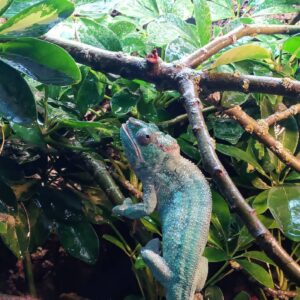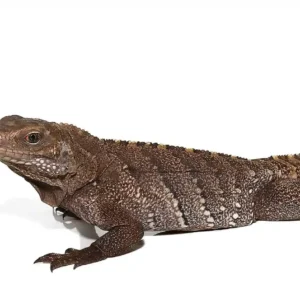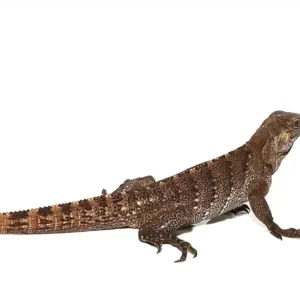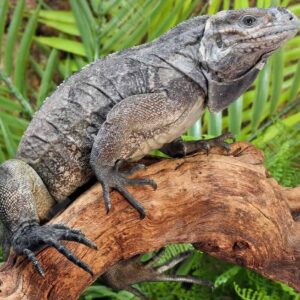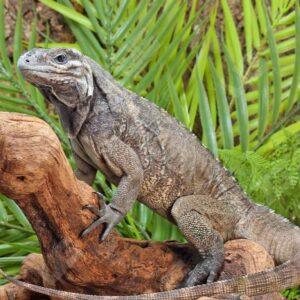Yellow Back Spiny Tail Iguana For Sale
$599.99
WE HAVE YELLOW BACK SPINY TAIL IGUANA FOR SALE. HERE ARE SOME HIGHLIGHTS:
- Ctenosaura flavidorsalis
- Field Collected
- Males and Females
- Approximately 10 – 15 Inches In Length From Head To Tail
- As Adults These Can Grow Up To 12 – 15 Inches In Length
- Feeding On Crickets, Worms, Greens, Fruits, And Various Other Insects
FUN FACTS!
- This Species Gains Bright Yellow And Orange Markings As It Matures
- These Can Be Feisty But Tame Down With Handling
- Originating From Central America From Nicaragua To Honduras
- These Are Mostly Terrestrial And Thrive In Hot/ Dry Climates Be Sure To Provide Plenty Of Heat And UVB
- With Proper Care These Can Live 15 – 25 Years In Captivity
Description
The Yellow Back Spiny Tail Iguana, scientifically known as Ctenosaura similis, is a remarkable reptile indigenous to Central America. This species primarily inhabits regions in countries such as Mexico, Honduras, and Nicaragua, thriving in a variety of environments ranging from dry forests to coastal areas. Its adaptability to different habitats underscores its resilience and has contributed significantly to its prevalence in the wild.
One of the most distinguishing features of the Yellow Back Spiny Tail Iguana is its unique coloration. As its name suggests, this iguana boasts a yellowish hue along its back, which can vary in intensity among individuals. This coloration is not only visually striking but also serves as a means of camouflage in its natural habitat. Additionally, this iguana is characterized by its spiny tail, a prominent feature that not only aids in locomotion but also acts as a formidable defense mechanism against predators.
Physically, the Yellow Back Spiny Tail Iguana is robust and agile, with adult males capable of reaching lengths up to 1.3 meters. Their strong limbs and sharp claws facilitate their arboreal lifestyle, allowing them to navigate trees and rocky terrains with ease. The spiny tail, in particular, is a distinctive adaptation, featuring a series of sharp, pointed scales that can be used effectively in self-defense.
In terms of conservation status, the Yellow Back Spiny Tail Iguana is considered to be relatively common within its native range. Unlike many other iguana species that face significant threats from habitat loss and human activities, Ctenosaura similis has managed to maintain stable populations. However, ongoing environmental changes and localized threats necessitate continuous monitoring to ensure their long-term survival.
Overall, the Yellow Back Spiny Tail Iguana is a fascinating species that exemplifies the rich biodiversity of Central America. Its distinctive physical characteristics and adaptability make it a subject of interest for both researchers and nature enthusiasts alike.
Physical Characteristics and Behavior
The yellow back spiny tail iguana, known for its distinctive appearance, is a remarkable reptile that captures the interest of herpetologists and enthusiasts alike. Typically, these iguanas measure between 14 to 20 inches in length, with some exceptional individuals reaching up to 24 inches. Their weight varies significantly, often ranging from 1 to 3 pounds, depending on factors such as age, diet, and habitat conditions.
The skin of the yellow back spiny tail iguana is a key identifier, characterized by a rough, textured surface adorned with a vibrant yellow stripe running along the back. This stripe contrasts sharply with the rest of the body, which may exhibit a mix of greens, browns, and blacks, providing excellent camouflage against the forest terrain. One of the most distinctive features is the spiny tail, which is not only visually striking but also serves as a formidable defense mechanism. The spikes deter predators, making the iguana a less appealing target.
Behaviorally, the yellow back spiny tail iguana exhibits fascinating patterns. Primarily herbivorous, its diet consists largely of leaves, fruits, and flowers, although it occasionally consumes insects. This dietary flexibility helps the iguana adapt to varying environmental conditions. Basking is another significant behavior; the iguana spends substantial time soaking up sunlight on rocks or branches, an activity vital for thermoregulation and overall health.
Socially, these iguanas display intriguing interactions. While generally solitary, they do engage in social behaviors during the breeding season. Males, in particular, exhibit territoriality, often displaying aggression to ward off rivals. Unique to the yellow back spiny tail iguana is its head-bobbing behavior, a form of communication used to assert dominance or attract mates.
In summary, the yellow back spiny tail iguana is an extraordinary species with distinct physical and behavioral traits that set it apart from other iguanas. Its vibrant coloration, spiny tail, and unique social behaviors contribute to its fascinating profile in the animal kingdom.
Habitat and Distribution
The yellow back spiny tail iguana (Ctenosaura flavidorsalis) is predominantly found in the tropical regions of Central America, where it thrives in diverse habitats. This resilient reptile has adapted to a variety of environments, ranging from rocky terrains to coastal areas and forests. The iguana’s preference for rocky terrains is largely due to the abundance of crevices and boulders, which offer excellent opportunities for basking and hiding from predators. In coastal areas, the yellow back spiny tail iguana takes advantage of the warmer, more humid climate and the rich availability of food sources such as insects and vegetation.
Forested areas also serve as a primary habitat for the yellow back spiny tail iguana. Here, the dense foliage provides ample cover and nesting sites, while the forest floor offers a smorgasbord of insects and plants. The iguana’s distribution is notably extensive across Central America, with significant populations observed in countries like Guatemala, Honduras, and El Salvador. Within these regions, the yellow back spiny tail iguana has shown remarkable adaptability to varying climatic conditions, from humid lowlands to arid highlands.
Several factors influence the habitat selection of the yellow back spiny tail iguana. Climate plays a crucial role, as these reptiles are ectothermic and rely heavily on external temperatures to regulate their body heat. The availability of food sources is another critical factor, with iguanas gravitating towards areas where insects, fruits, and vegetation are plentiful. Furthermore, human activity and habitat destruction have also impacted their distribution, pushing some populations into more secluded and less disturbed areas.
Interestingly, there are notable subpopulations and variations of the yellow back spiny tail iguana in different regions. For instance, iguanas inhabiting coastal areas tend to exhibit slightly different coloration and size compared to those found in inland rocky terrains. These variations are a testament to the species’ ability to adapt to its environment, ensuring its survival across a wide range of habitats in Central America.
Diet and Feeding Habits
The yellow back spiny tail iguana, known for its diverse dietary preferences, exhibits a remarkable range in its feeding habits. Primarily herbivorous, these iguanas consume a variety of fruits, vegetables, and flowers. They particularly favor leafy greens and brightly colored fruits, which provide essential vitamins and hydration. Their diet, however, is not strictly plant-based. Insects and small animals occasionally supplement their nutritional intake, especially in times of food scarcity or specific developmental stages.
Foraging for food involves both ground and arboreal activities. The yellow back spiny tail iguana is adept at climbing trees and bushes to access fruits and tender leaves. On the ground, it scours the forest floor for fallen fruits and edible vegetation. This dual foraging strategy helps the iguana maximize its food sources and adapt to various environmental conditions.
A distinctive feeding behavior observed in these iguanas is their method of selecting and processing food. They use their sharp claws and powerful jaws to tear apart larger fruits and vegetables. Insects and smaller prey are caught with a swift, precise bite. This efficient feeding technique ensures they can consume a wide range of food items, meeting their diverse nutritional needs.
Nutritionally, the yellow back spiny tail iguana requires a balanced intake of carbohydrates, proteins, and fats, with a significant emphasis on calcium for bone health. Young iguanas tend to consume more protein-rich food such as insects to support their rapid growth, while adults favor a more plant-based diet. Seasonal changes also influence their diet, with rainy seasons providing an abundance of fresh vegetation and dry seasons necessitating a reliance on hardier, less perishable food sources.
Despite their versatile diet, yellow back spiny tail iguanas face threats from various predators, including birds of prey, snakes, and larger mammals. To avoid predation, they rely on their agility and camouflage. Their spiny tails serve as a defensive weapon, deterring potential attackers and providing a means of escape. This combination of adaptive feeding habits and defensive mechanisms contributes to the yellow back spiny tail iguana’s survival in its natural habitat.
Reproduction and Lifespan
The yellow back spiny tail iguana exhibits a unique and fascinating reproductive cycle that is integral to its survival. Mating behaviors typically occur during the warmer months, when males become more territorial and display distinctive courtship rituals to attract females. This period is characterized by increased physical activity, vibrant color displays, and specific body movements to signal readiness for mating.
The gestation period for the yellow back spiny tail iguana ranges from 60 to 90 days, post which the female seeks an appropriate site to lay her eggs. The egg-laying process is a critical phase, as the female carefully selects a warm and secure location to ensure the safety and development of her offspring. A typical clutch size varies, but it generally consists of 10 to 20 eggs. These eggs require an incubation period of approximately 80 to 90 days, depending on environmental conditions such as temperature and humidity.
Upon hatching, the young iguanas face several survival challenges. The early life stages are marked by rapid growth rates, with juveniles having to fend for themselves almost immediately. They exhibit remarkable adaptability, but predation and environmental factors significantly influence their survival rates. Growth continues steadily, and by the time they reach adulthood, they have established a stable presence in their habitat.
The lifespan of the yellow back spiny tail iguana varies between wild and captive environments. In the wild, these iguanas can live up to 15 years, though this is often reduced due to natural predators and habitat conditions. In captivity, with optimal care, including a controlled diet and environment, their lifespan can extend up to 20 years. This extended lifespan in captivity underscores the importance of proper care and management for the preservation of this species.
Conservation Status and Threats
The yellow back spiny tail iguana (Ctenosaura flavidorsalis) is currently classified as vulnerable on the International Union for Conservation of Nature (IUCN) Red List. This classification indicates that the species is at a high risk of endangerment in the wild. Various factors contribute to this precarious status, with habitat destruction being one of the most significant threats. Rapid deforestation and land conversion for agriculture and urban development have led to the fragmentation and loss of the iguana’s natural habitat, severely impacting their population.
Another pressing threat facing the yellow back spiny tail iguana is the illegal pet trade. These iguanas are often captured and sold as exotic pets, which not only reduces their numbers in the wild but also disrupts their natural breeding patterns. Additionally, climate change poses a long-term threat by altering the ecosystems where these iguanas thrive. Changes in temperature and weather patterns can affect their food sources and habitat conditions, further endangering the species.
Numerous conservation efforts are underway to protect and preserve the yellow back spiny tail iguana population. Various organizations and research institutions are working on habitat restoration projects and creating protected areas to secure the iguana’s natural environment. Community education programs are also being implemented to raise awareness about the importance of conserving this unique species and to combat the illegal pet trade.
There have been some success stories in the conservation of the yellow back spiny tail iguana. For instance, certain protected areas have seen a stabilization or even an increase in iguana populations due to concerted conservation efforts. However, challenges remain, especially in enforcing laws against illegal trade and mitigating the impacts of climate change. Ongoing research and international collaboration are essential to ensuring the long-term survival of this fascinating species.
Captive Care and Pet Ownership
Owning a yellow back spiny tail iguana (Ctenosaura similis) can be a rewarding experience, provided the proper care and environment are maintained. These iguanas, known for their striking appearance and resilient nature, require specific conditions to thrive in captivity.
The enclosure setup is crucial for the well-being of the yellow back spiny tail iguana. A spacious terrarium, measuring at least 6 feet long, 3 feet wide, and 4 feet tall, is recommended to provide ample room for movement. Constructing the enclosure with materials that retain heat and allow for proper ventilation is essential. Additionally, incorporating climbing structures, hideouts, and foliage can mimic the iguana’s natural habitat, promoting mental and physical stimulation.
Temperature and humidity play vital roles in the health of the yellow back spiny tail iguana. Maintain a basking area temperature between 95-100°F, with a cooler side ranging from 75-85°F. Ensure that the enclosure temperature does not drop below 70°F at night. Humidity should be kept between 60-80%, achievable through regular misting and the use of humidity-retaining substrates. Utilizing thermometers and hygrometers can help monitor these conditions accurately.
Diet is another critical aspect of caring for yellow back spiny tail iguanas. These iguanas are primarily herbivores, with a diet comprising leafy greens, vegetables, and occasional fruits. Provide a variety of nutrient-rich foods such as collard greens, mustard greens, and dandelion leaves. Supplement their diet with calcium and vitamin D3 to prevent deficiencies and support bone health.
Regular health care is paramount for maintaining the vitality of your pet iguana. Schedule routine veterinary check-ups to monitor for common health issues such as metabolic bone disease, parasites, and respiratory infections. Early detection and treatment are vital for the longevity and quality of life of your iguana.
Potential owners should also be aware of legal considerations. In some regions, owning a yellow back spiny tail iguana may require permits or adherence to specific regulations. It is advisable to check local wildlife laws and obtain any necessary documentation before acquiring one as a pet.
Providing an environment that closely resembles the yellow back spiny tail iguana’s natural habitat is essential for its well-being. With proper care, attention to detail, and adherence to legal requirements, these captivating reptiles can make fascinating and fulfilling pets.
Interesting Facts and Myths
The Yellow Back Spiny Tail Iguana, scientifically known as Ctenosaura flavidorsalis, is a captivating reptile native to Central America. One fascinating fact about this iguana is its striking coloration. As its name suggests, it features a distinctive yellow band along its back, which becomes more pronounced during the mating season. This vibrant hue not only plays a role in attracting mates but also serves as a deterrent to potential predators, signaling that the iguana may be poisonous or dangerous, although it is neither.
A common myth about the Yellow Back Spiny Tail Iguana is that it is highly aggressive towards humans. Contrary to this belief, these iguanas are typically shy and prefer to flee rather than fight when approached. Their spiny tails, which can be used defensively, are more often employed to fend off small predators or rivals within their species rather than humans. This misconception likely stems from their impressive defensive displays, which include puffing up their bodies and displaying their formidable tails.
In terms of behavior, these iguanas are known for their arboreal lifestyle. They spend a significant amount of time in trees, using their sharp claws and long tails to navigate the branches. This adaptation not only helps them evade ground predators but also allows them to access a diverse diet, which includes fruits, flowers, insects, and small vertebrates. Their omnivorous diet is essential for their survival, especially in habitats where food availability can fluctuate.
One lesser-known detail about the Yellow Back Spiny Tail Iguana is its role in the ecosystem as both predator and prey. Juvenile iguanas are prey for birds, snakes, and larger mammals, while adult iguanas help control insect populations and disperse seeds through their diet. This dual role underscores the iguana’s importance in maintaining ecological balance.
Culturally, the Yellow Back Spiny Tail Iguana holds significance in various indigenous communities. In some cultures, it is believed that the iguana brings good fortune or serves as a symbol of resilience due to its hardy nature and adaptability. Historical anecdotes also suggest that these iguanas were occasionally kept as pets by ancient civilizations, valued for their unique appearance and docile temperament.






